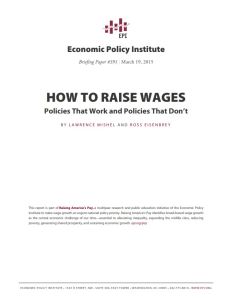Join getAbstract to access the summary!

Join getAbstract to access the summary!
Lawrence Mishel and Ross Eisenbrey
How to Raise Wages
Policies That Work and Policies That Don’t
EPI, 2015
What's inside?
Can the US address the imbalance between stagnant wages and productivity growth without falling into partisanship?
Recommendation
Economists Lawrence Mishel and Ross Eisenbrey of the Economic Policy Institute note that wages in the United States have stagnated for years, even for college-educated workers, while productivity has soared. That’s probably the only point in this paper that will win agreement from fiscal conservatives. Much of the advice here – such as raise the minimum wage and offer paid leave, but skip the tax cuts – falls along partisan lines. Though always politically neutral, getAbstract recommends this report for the way it deftly limns critical wage and growth issues.
Summary
About the Authors
Lawrence Mishel and Ross Eisenbrey are president and VP of the Economic Policy Institute.





















Comment on this summary